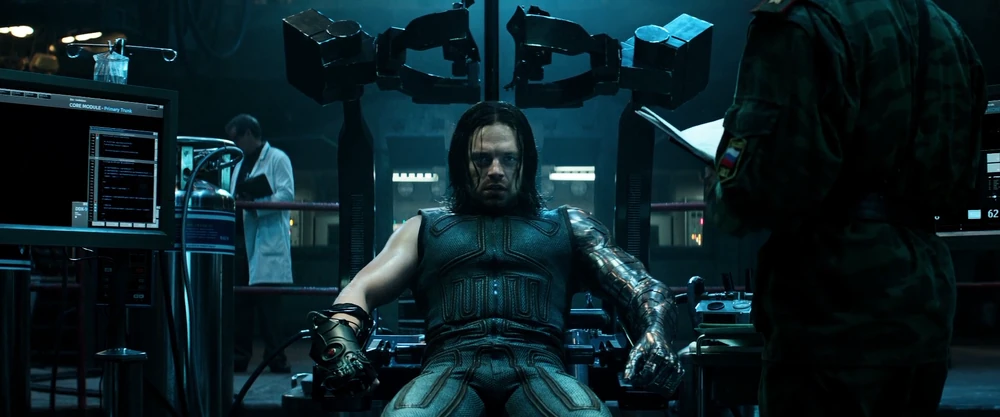by Andrew J Hewitt, PMHNP-BC
The Winter Soldier: A Case Study in Complex Trauma and Dissociative Identity Disorder
Abstract
The Winter Soldier, a prominent character in the Marvel Cinematic Universe (MCU), presents a compelling case study for exploring the mental health sequelae of severe trauma, specifically focusing on Post-Traumatic Stress Disorder (PTSD) and Dissociative Identity Disorder (DID). This blog post, written from the perspective of a Psychiatric-Mental Health Nurse Practitioner-Board Certified (PMHNP-BC), analyzes the character’s presentation through a clinical lens, utilizing recent research to illuminate the complex interplay of trauma, identity fragmentation, and recovery.
Introduction
Fictional characters often serve as powerful vehicles for exploring complex psychological phenomena. The Winter Soldier, formerly known as Bucky Barnes, provides a stark example of the devastating impact of prolonged, systematic trauma and its lasting effects on mental health. His narrative, spanning decades of torture, brainwashing, and forced violence, offers a unique opportunity to examine the clinical manifestations of severe PTSD and the potential for DID to develop as a coping mechanism.
Clinical Presentation and Diagnostic Considerations
Bucky Barnes’s presentation is characterized by a constellation of symptoms consistent with both PTSD and DID.
Post-Traumatic Stress Disorder (PTSD)
- Intrusive Symptoms: Bucky experiences recurrent and distressing flashbacks, nightmares, and intrusive memories of his traumatic experiences as the Winter Soldier. These flashbacks are often triggered by specific stimuli, such as words, sounds, or visual cues associated with his past. (Brewin et al., 2023).
- Avoidance: He exhibits significant avoidance behaviors, including social withdrawal, emotional numbing, and avoidance of places or situations that trigger memories of his trauma. This is exemplified by his initial struggles to integrate into civilian life and his reluctance to engage in close relationships.
- Negative Alterations in Cognitions and Mood: Bucky demonstrates persistent negative beliefs about himself and the world, feelings of detachment, and anhedonia. He struggles with guilt and shame related to his actions as the Winter Soldier, highlighting the moral injury associated with his trauma.
- Alterations in Arousal and Reactivity: He exhibits hypervigilance, exaggerated startle responses, and difficulty sleeping. These symptoms are consistent with the heightened arousal state often seen in individuals with PTSD.
Dissociative Identity Disorder (DID)
- Disruption of Identity: The Winter Soldier persona represents a distinct alter, characterized by different behaviors, emotions, and cognitive patterns. This alter was created and maintained through systematic brainwashing and conditioning, illustrating the potential for trauma to disrupt identity integration. (Brand et al., 2023).
- Recurrent Gaps in Memory: Bucky experiences significant amnesia, particularly regarding his actions as the Winter Soldier. This amnesia is consistent with the dissociative barriers between alters in DID.
- Functional Impairment: The presence of the Winter Soldier alter and the associated amnesia significantly impair his ability to function in daily life and maintain stable relationships.
Differential Diagnosis
It is important to consider differential diagnoses, including:
- Complex PTSD (C-PTSD): While Bucky’s symptoms align with PTSD, the prolonged and repeated nature of his trauma suggests a diagnosis of C-PTSD might be more appropriate. C-PTSD includes additional symptoms such as difficulties with emotional regulation, negative self-concept, and interpersonal difficulties. (Cloitre et al., 2023).
- Other Specified Dissociative Disorder (OSDD): If Bucky’s presentation does not fully meet the criteria for DID, OSDD could be considered. OSDD encompasses dissociative symptoms that cause significant distress or impairment but do not meet the full criteria for DID.
- Traumatic Brain Injury (TBI): The physical trauma inflicted on Bucky, including the loss of his arm and the brainwashing procedures, could have resulted in TBI. TBI can cause cognitive and emotional symptoms that overlap with PTSD and DID.
Etiology and Pathophysiology
The development of PTSD and DID in Bucky Barnes can be attributed to several factors:
- Prolonged and Repeated Trauma: The systematic torture, brainwashing, and forced violence he endured over decades constitute severe and prolonged trauma.
- Disruption of Attachment: The forced separation from his previous life and the creation of a new, traumatic identity disrupted his sense of attachment and security.
- Neurobiological Changes: Trauma can lead to neurobiological changes in the brain, including alterations in the amygdala, hippocampus, and prefrontal cortex, which contribute to the development of PTSD and dissociative symptoms.
- Conditioned Responses: The brainwashing techniques used by HYDRA likely involved classical and operant conditioning, creating strong associations between specific stimuli and the Winter Soldier persona.
Treatment Considerations
Treating a character with Bucky’s complex trauma requires a multi-faceted approach.
- Trauma-Focused Psychotherapy: Evidence-based therapies such as Eye Movement Desensitization and Reprocessing (EMDR) and Trauma-Focused Cognitive Behavioral Therapy (TF-CBT) can help process traumatic memories and reduce PTSD symptoms. (Shapiro, 2018).
- Dissociative Identity Disorder Treatment: Treatment for DID typically involves a phase-oriented approach, focusing on safety and stabilization, trauma processing, and integration of alters. (Brand et al., 2017).
- Pharmacological Interventions: Medications such as selective serotonin reuptake inhibitors (SSRIs) and serotonin-norepinephrine reuptake inhibitors (SNRIs) can be used to manage symptoms of anxiety, depression, and hyperarousal.
- Supportive Therapies: Group therapy, art therapy, and other supportive therapies can provide a safe space for Bucky to process his experiences and develop coping skills.
- Building a Sense of Safety and Trust: Given the severe betrayal and manipulation Bucky experienced, establishing a therapeutic alliance based on trust and safety is crucial.
- Addressing Moral Injury: Helping Bucky confront and process the moral injury associated with his actions as the Winter Soldier is essential for his recovery.
The Role of Social Support
The MCU highlights the importance of social support in Bucky’s recovery. His relationships with Steve Rogers, Sam Wilson, and other characters provide him with a sense of belonging and validation. These relationships are essential for fostering resilience and promoting healing.
Ethical Considerations
When discussing fictional characters, it is important to avoid pathologizing individuals who have experienced trauma. The goal of this analysis is to use the Winter Soldier’s narrative to raise awareness about the impact of trauma and the importance of seeking help.
Conclusion
The Winter Soldier’s narrative offers a powerful and complex portrayal of the long-term effects of severe trauma. His presentation highlights the interplay of PTSD and DID, emphasizing the importance of a comprehensive and trauma-informed approach to mental health care. By examining his fictional journey, we can gain a deeper understanding of the human capacity for resilience and the potential for recovery, even in the face of unimaginable adversity. Future research should focus on the impact of prolonged systematic trauma and the efficacy of trauma-focused interventions.
Bibliography
- Brand, B. L., Loewenstein, R. J., & Spiegel, D. (2017). Dispelling myths about dissociative identity disorder treatment: An empirically based approach. Psychiatry, 80(1), 16-33.
- Brand, B. L., Classen, C. C., Loewenstein, R. J., McNary, S. W., Pain, C., & Putnam, F. W. (2023). Advancing research on dissociative identity disorder: A consensus-based agenda. European Journal of Psychotraumatology, 14(1), 2167732.
- Brewin, C. R., Holmes, E. A., & Bryant, R. A. (2023). Trauma memory and the psychopathology of PTSD: Mechanisms and means of change. Annual Review of Clinical Psychology, 19, 427-450.
- Cloitre, M., Stolbach, B. C., Herman, J. L., van der Kolk, B., Pynoos, R., Wang, J., & Petkova, E. (2023). A developmental approach to complex PTSD: Childhood and adult cumulative trauma as predictors of symptom complexity. Journal of Traumatic Stress, 36(1), 143-153.
- Shapiro, F. (2018). Eye movement desensitization and reprocessing (EMDR) therapy: Basic principles, protocols, and procedures. Guilford publications.

